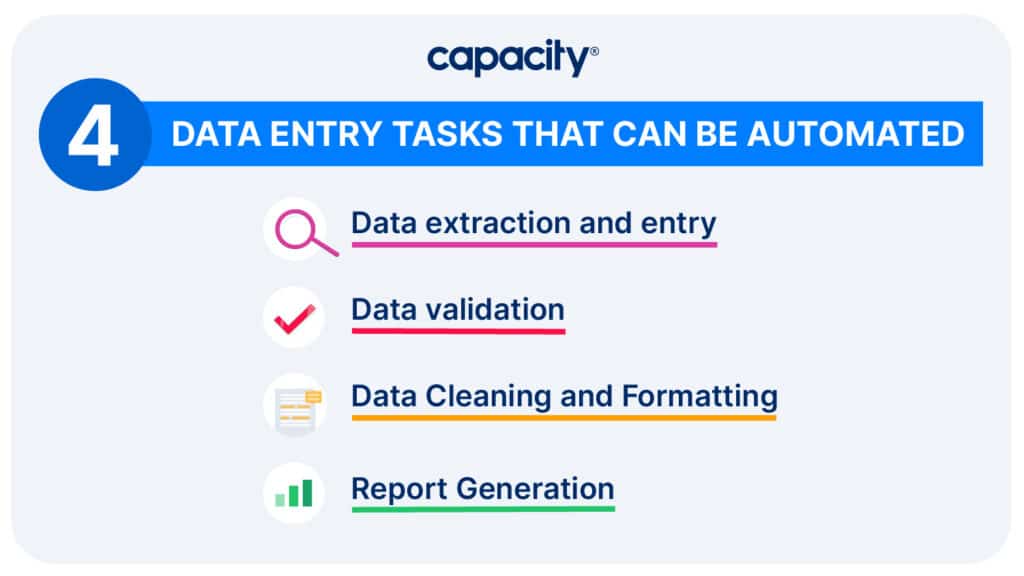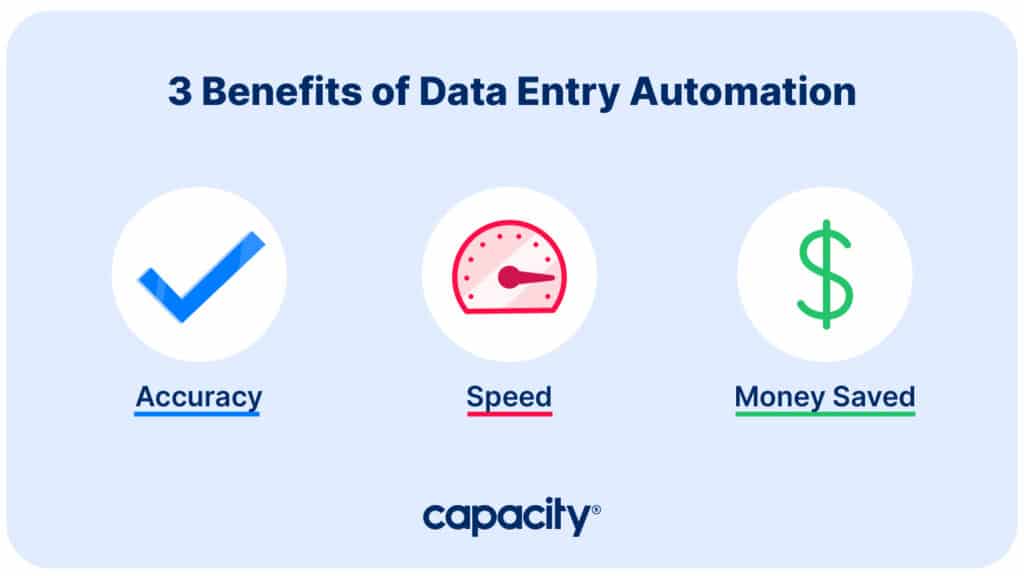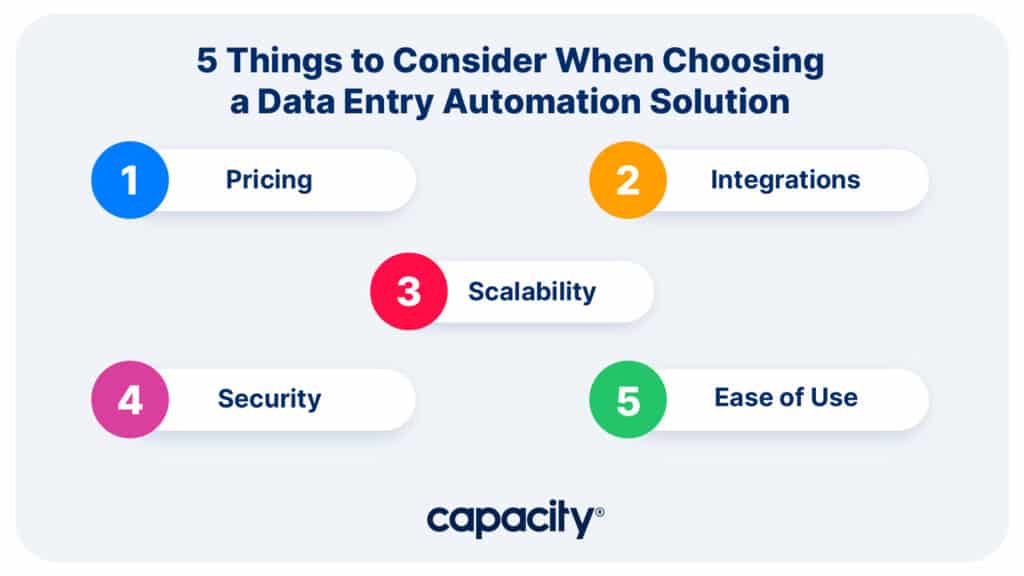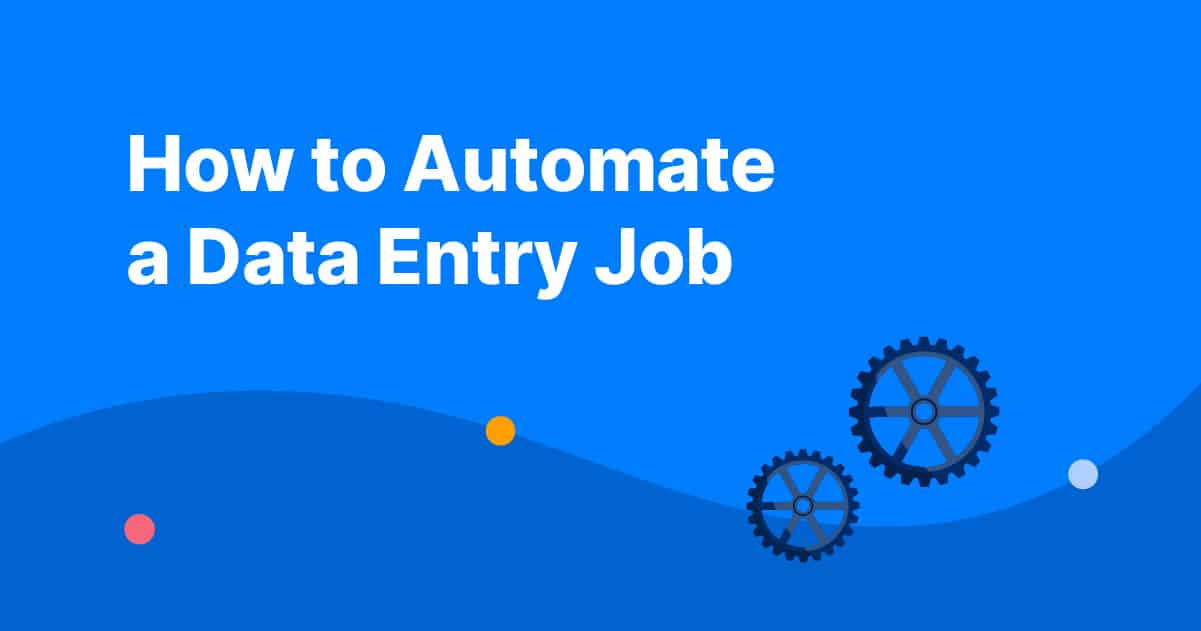Data entry automation is essential for businesses looking to streamline their operations and reduce costs. By automating data entry tasks, companies can increase accuracy, save time and money, and improve efficiency. Automation can also help organizations manage large amounts of data more quickly and easily, reducing the risk of human error in manual processes.
In this post, we will explore what data entry tasks can be automated, the business benefits of automation, and how to choose the right solution.

Streamline Complex Processes Instantly
Capacity’s AI and automation technology can help:
- Answer FAQs anytime, anywhere
- Find relevant documents within seconds
- Give surveys and collect feedback
Let’s start with a definition. Data entry automation is the use of robotic process automation (RPA) and other AI tools to automate manual data entry tasks.
With RPA, it is possible to build rules-based systems that can automatically capture, store, organize, and analyze data. By shifting low-level, mundane work to automation, the burden of time-staking labor decreases. So does the risk of human error.
So what exactly can be automated in a data entry job?

The possibilities are endless when considering how to automate a data entry job. But here are just a few things automation can do:
Data Extraction and Entry
Advanced RPA can extract information from digital documents like invoices, policies, and forms. It can then populate your chosen system or destination with the relevant data.
Keep in mind that your automation solution should connect with all your key systems, so that you make the most out of your technology and nothing is lost in translation.
Data Validation
Automation technology uses algorithms to independently check that data is accurate and relevant. For instance, if you’re entering customer addresses into a record system, the software can check that the addresses are in the right format and have the correct postal code. RPA can also check for data duplicates.
Data Cleaning and Formatting
Avoid the burden of having to manually clean and format data, and let automation do it for you. RPA can remove duplicate or incorrect entries, which is especially useful for large and complicated datasets. Software can also automatically format your data for you, saving hours of finicky setting configurations.
Report Generation
Automatic analysis capabilities can be used to create reports based on your data, saving your team hours of time and ensuring absolute accuracy.

What are the benefits of data entry automation?
The most obvious benefit of data entry automation is increased accuracy. RPA can work 24/7/365 with no distractions or need for sleep, and it’ll never miss a decimal point. Automated systems eliminate human error and reduce processing time, sometimes by more than half.
Additionally, automation can process large amounts of data within moments. Tedious and repetitive tasks, such as entering customer information into a database or updating inventory records, can be completed instantly. A faster data entry process means that staff has more time to focus on productive, human-centered tasks. KPIs and other deliverables can be met much faster, so the workflow of the entire department improves.
But the most important benefit of data entry automation for your business is money saved. Instead of relying on costly, time-consuming data entry processes, companies can save money and devote resources towards more important business strategies.
How do I choose the right data entry automation solution?
Investing in technology for your business can be overwhelming. When evaluating potential solutions, it is important to consider a variety of factors such as cost, scalability, security, and ease of use. Ultimately, choose the tool that best fits your business goals.

One of the most important factors to consider is pricing. Take into account both the upfront costs of the automation solution and any ongoing maintenance costs. Some solutions may require hefty initial investments, while others are more cost-effective long-term.
The second most important factor is integration capabilities. Ensure the solution can connect with your existing databases, CRMs, email, and any other system you use for work.
Additionally, consider scalability. As your business grows, you’ll want to expand your data entry capabilities. Choose a solution that can be easily scaled to meet your future needs. This will help to ensure that you don’t outgrow your technology too quickly.
Security is also a priority. Ensure that your data is kept safe and compliant with relevant regulations, like GDPR or HIPAA. This includes robust protection against unauthorized access. Also look for solutions that provide regular updates and patches to ensure that any security vulnerabilities are fixed quickly.
Finally, make sure it’s useful! The ultimate goal of data entry automation is to make work and life easier. Choose a solution that is easy to use and teach, so your team can quickly adapt. Whatever technology you choose should streamline processes and increase efficiency over the long term. A great way to measure this is by collecting constant feedback from users.
What’s the next step to automating a data entry job?
Once you’ve chosen the right data entry automation solution, it’s time to implement!
Start small at first. Many solutions have out-of-the-box capabilities that are relatively simple, but effective. Once you have a reliable foundation, explore the possibilities of what data entry can do! Scale your process, analyze performance, rinse, and repeat.
And don’t worry: you’re not in this alone. Most automation solutions, like Capacity, have dedicated Customer Success teams to assist you. They can help with implementation, training, trouble-shooting, and expanding—so be sure to rely on their expertise!
In conclusion, data entry automation is crucial for businesses looking to streamline their operations and reduce costs. Automating data entry tasks can increase accuracy, save time and money, and improve efficiency while reducing the risk of human error in manual processes.
By leveraging the power of automated systems, businesses can focus on more productive activities that will help them succeed in today’s competitive market.





